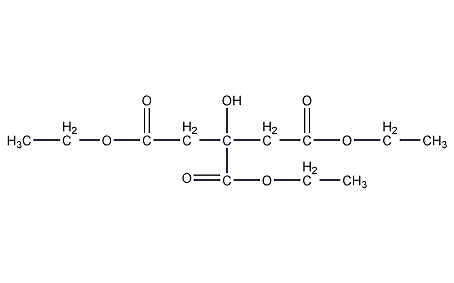
Structural formula
| Business number | 01MG |
|---|---|
| Molecular formula | C12H20O7 |
| Molecular weight | 276.28 |
| label |
Triethyl 2-hydroxy-1,2,3-propanetricarboxylate, Triethyl citrate, Triethyl 2-hydroxy-1,2,3-propanetricarboxylate, Triethyl citrate, Citric Acid Triethyl Ester, 2-Hydroxypropane-1,2,3-tricarboxylic Acid Triethyl Ester, HOC(COOC2H5)(CH2COOC2H5)2, Nitrocellulose solvent, Plasticizer |
Numbering system
CAS number:77-93-0
MDL number:MFCD00009201
EINECS number:201-070-7
RTECS number:GE8050000
BRN number:1801199
PubChem number:24856620
Physical property data
1. Properties: Colorless and transparent liquid, with sweet and pleasant fruit wine, plum-like aroma
2. Density (g/mL, 20/4℃): 1.1369
3. Refractive index at room temperature (n20): 1.4455
4. Melting point (ºC): -55
5. Boiling point (ºC, normal Pressure): 294
6. Boiling point (ºC, 0.133kPa): 127
7. Refractive index (20ºC): 1.4455
8. Flash point ( ºC): 110
9. Specific optical rotation (º): Uncertain
10. Autoignition point or ignition temperature (ºC): Uncertain
11. Vapor pressure (kPa, 25ºC): Uncertain
12. Saturation vapor pressure (kPa, 60ºC): Uncertain
13. Heat of combustion (KJ/mol): Uncertain Determined
14. Critical temperature (ºC): Uncertain
15. Critical pressure (KPa): Uncertain
16. Oil and water (octanol/water ) Log value of distribution coefficient: Uncertain
17. Explosion upper limit (%, V/V): Uncertain
18. Explosion lower limit (%, V/V): Uncertain Confirm
19. Solubility: Soluble in most organic solvents. Insoluble in oils. It has good compatibility with most cellulose, polyvinyl chloride, polyvinyl acetate resin and chlorinated rubber. Solubility in water at 25°C is 6.5g/100mL.
Toxicological data
1. Acute toxicity: Rat diameter LD50: 5900 mg/kg; rats inhaled LC50: 1300PPM/6h;
Rat abdominal cavity LD50: 4 mg/kg; rats LD50: 6600mg subcutaneously /kg;
Mouse abdominal LD50: 1750 mg/kg; cat caliber LD50: 3500mg/kg;
2. Other multiple dose toxicity data: mouse abdominal LD50: 4900mg/kg/14D-I; cat caliber TDLO: 15904 mg/kg/8W-C
Ecological data
None yet
Molecular structure data
1. Molar refractive index: 64.46
2. Molar volume (cm3/mol): 234.6
3. Isotonic specific volume (90.2K ): 595.5
4. Surface tension (dyne/cm): 41.5
5. Polarizability (10-24cm3): 25.55
Compute chemical data
1. Reference value for hydrophobic parameter calculation (XlogP): 0.1
2. Number of hydrogen bond donors: 1
3. Number of hydrogen bond acceptors: 7
4. Number of rotatable chemical bonds: 11
5. Number of tautomers: none
6. Topological molecule polar surface area 99.1
7. Number of heavy atoms: 19
8. Surface charge: 0
9. Complexity: 304
10. Number of isotope atoms: 0
11. Determine the number of atomic stereocenters: 0
12. Uncertain number of atomic stereocenters: 0
13. Determine the number of chemical bond stereocenters: 0
14. Number of uncertain chemical bond stereocenters: 0
15. Number of covalent bond units: 1
Properties and stability
Colorless transparent liquid. It has a sweet and pleasant fruit wine, plum-like aroma. Soluble in most organic solvents. Insoluble in oils. It has good compatibility with most cellulose, polyvinyl chloride, polyvinyl acetate resin and chlorinated rubber. Solubility in water (25℃) 6.5g/100cm3.
Storage method
This product should be sealed and stored in a cool, dry place.
Synthesis method
It is produced by direct esterification of citric acid and ethanol, and then through refining processes such as neutralization, water washing, and dealcoholization.
Purpose
Due to its strong solubility, good oil resistance and light resistance, it is mainly used as a plasticizer for thermoplastic resins such as cellulose and vinyl. Also used in the paint industry. It can be used as berry-type food flavor, and the final food content can reach 200mg/kg. Also used as a solvent for nitrocellulose.

 微信扫一扫打赏
微信扫一扫打赏

